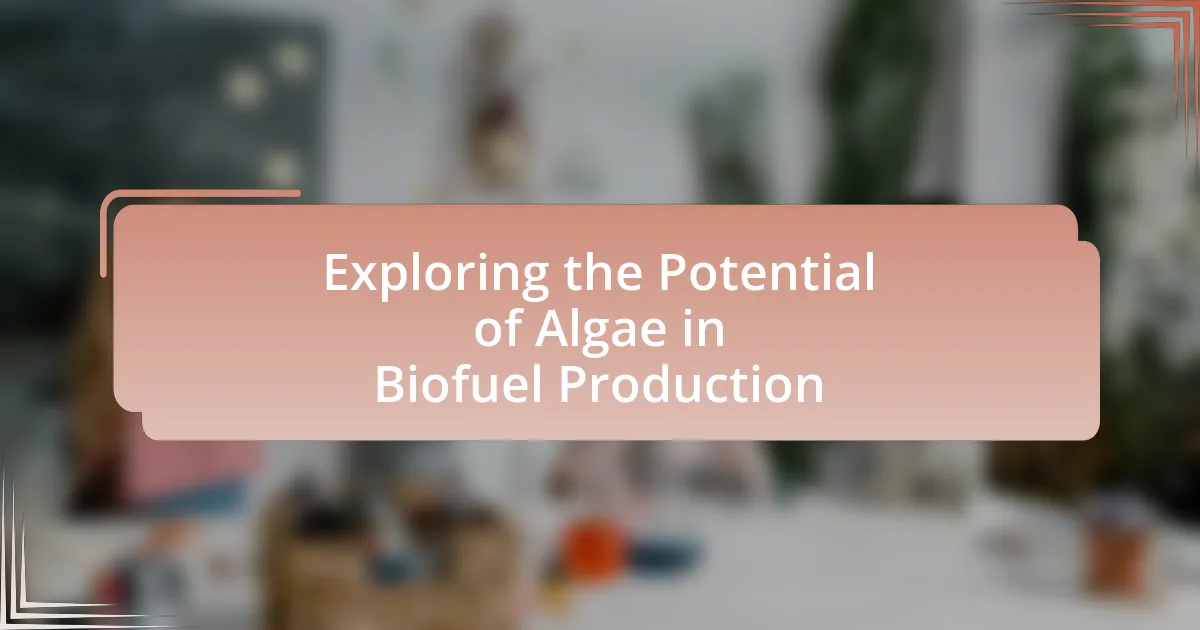Algae are increasingly recognized as a vital resource in biofuel production due to their high lipid content, which can be converted into biodiesel. Certain species of microalgae can yield significantly more oil per acre compared to traditional crops, making them a more efficient feedstock. The article explores the biological processes involved in algae biofuel production, the environmental benefits of using algae over fossil fuels, and the challenges faced in scaling up production. It also discusses the economic barriers, technological advancements needed, and the role of government policies in promoting algae biofuels. Additionally, best practices for integrating algae biofuels into existing energy systems and practical steps individuals can take to support these initiatives are highlighted.

What is the role of algae in biofuel production?
Algae play a crucial role in biofuel production as they are a rich source of lipids, which can be converted into biodiesel. Specifically, certain species of algae can produce up to 50% of their dry weight in oils, making them more efficient than traditional crops like soybeans or corn. Research indicates that algae can yield 5 to 20 times more oil per acre than these conventional sources, significantly enhancing biofuel output. Additionally, algae can grow in a variety of environments, including saltwater and wastewater, which allows for sustainable production without competing for arable land.
How do algae contribute to renewable energy sources?
Algae contribute to renewable energy sources primarily through their ability to produce biofuels, such as biodiesel and bioethanol. These microorganisms can convert sunlight, carbon dioxide, and nutrients into biomass at a rapid rate, with some species capable of doubling their biomass in less than a day. Research indicates that algae can produce up to 30 times more oil per acre than traditional crops like soybeans, making them a highly efficient feedstock for biofuel production. Additionally, algae can utilize wastewater and carbon emissions, thus providing a sustainable method for energy generation while simultaneously addressing environmental issues.
What types of algae are most effective for biofuel production?
The most effective types of algae for biofuel production are microalgae, particularly species such as Chlorella, Spirulina, and Scenedesmus. Microalgae have high lipid content, often exceeding 50% of their dry weight, which is essential for biodiesel production. For instance, Chlorella vulgaris has been shown to produce up to 30% of its biomass as lipids, making it a prime candidate for biofuel applications. Additionally, Spirulina platensis is recognized for its rapid growth rate and high protein content, contributing to its viability in biofuel production. Research indicates that Scenedesmus obliquus can yield significant amounts of oil, with studies reporting lipid extraction rates of around 30-40%. These characteristics make these algae particularly suitable for sustainable biofuel production.
What are the biological processes involved in algae biofuel production?
The biological processes involved in algae biofuel production primarily include photosynthesis, lipid accumulation, and biomass conversion. During photosynthesis, algae convert sunlight, carbon dioxide, and water into organic compounds, primarily carbohydrates, which serve as energy sources. This process is crucial as it forms the foundation for biomass generation.
Subsequently, under specific environmental conditions, algae can accumulate lipids, which are essential for biofuel production. Studies indicate that certain species of microalgae can contain up to 50% of their dry weight in lipids, making them highly efficient for biofuel extraction.
Finally, the biomass produced through these processes can be converted into biofuels through various methods, including transesterification, where lipids are transformed into biodiesel. This multi-step biological process highlights the efficiency of algae as a renewable energy source, supported by research showing that algae can produce up to 30 times more oil per acre than traditional crops.
Why is algae considered a sustainable option for biofuels?
Algae is considered a sustainable option for biofuels because it has a high growth rate and can be cultivated on non-arable land, minimizing competition with food crops. Algae can produce significantly more oil per acre compared to traditional biofuel sources; for instance, certain strains can yield up to 5,000 gallons of oil per acre annually, whereas soybeans yield about 50 gallons per acre. Additionally, algae can utilize carbon dioxide from industrial emissions, thereby contributing to greenhouse gas reduction. This dual capability of high oil yield and carbon sequestration supports its classification as a sustainable biofuel source.
What environmental benefits does algae biofuel offer compared to fossil fuels?
Algae biofuel offers significant environmental benefits compared to fossil fuels, primarily through reduced greenhouse gas emissions and lower ecological impact. Algae can absorb carbon dioxide during growth, potentially offsetting emissions produced when the biofuel is burned. Studies indicate that algae biofuels can reduce carbon emissions by up to 70% compared to traditional fossil fuels. Additionally, algae cultivation requires less land and water than conventional crops, minimizing habitat destruction and resource depletion. Furthermore, algae can be grown in non-arable land and utilize wastewater, which helps in nutrient recycling and reduces pollution. These factors collectively demonstrate that algae biofuel presents a more sustainable alternative to fossil fuels.
How does algae cultivation impact carbon dioxide levels?
Algae cultivation significantly reduces carbon dioxide levels by absorbing CO2 during photosynthesis. This process allows algae to convert carbon dioxide into biomass, effectively sequestering carbon from the atmosphere. Studies indicate that certain algae species can absorb up to 1.8 tons of CO2 per ton of biomass produced. For instance, research published in the journal “Bioresource Technology” demonstrates that microalgae can capture CO2 emissions from industrial sources, thereby mitigating greenhouse gas emissions.

What are the challenges in using algae for biofuel production?
The challenges in using algae for biofuel production include high cultivation costs, low oil yield, and technical difficulties in harvesting and processing. Cultivation costs are elevated due to the need for specific growth conditions, such as light, temperature, and nutrients, which can be expensive to maintain. Additionally, many algal species produce oil yields that are lower than required for economic viability, often necessitating the use of genetically modified strains to enhance productivity. Technical difficulties arise during the harvesting process, as separating algae from water can be inefficient and costly, and the subsequent processing to extract oil involves complex methods that can further increase expenses. These factors collectively hinder the scalability and commercial viability of algae-based biofuels.
What are the economic barriers to algae biofuel production?
The economic barriers to algae biofuel production include high production costs, limited scalability, and competition with established fossil fuels. High production costs arise from the need for advanced technology and infrastructure for cultivation and processing, which can exceed $10 per gallon, making it economically unviable compared to fossil fuels priced around $2 to $3 per gallon. Limited scalability is a challenge as current production methods cannot meet the large-scale demand for biofuels, and the technology for efficient harvesting and processing is still under development. Additionally, established fossil fuel markets benefit from significant subsidies and infrastructure, making it difficult for algae biofuels to compete on price and availability.
How do production costs compare to traditional biofuels?
Production costs for algae-based biofuels are generally higher than those for traditional biofuels. Traditional biofuels, such as corn ethanol and soybean biodiesel, benefit from established agricultural practices and economies of scale, resulting in production costs ranging from $1.00 to $1.50 per gallon. In contrast, algae biofuels face challenges such as high cultivation, harvesting, and processing costs, which can exceed $5.00 per gallon. Research indicates that while advancements in technology and methods may reduce these costs over time, as of now, algae biofuels remain more expensive compared to their traditional counterparts.
What technological advancements are needed to overcome these challenges?
To overcome the challenges in algae biofuel production, advancements in genetic engineering, cultivation techniques, and processing technologies are essential. Genetic engineering can enhance algal strains for higher lipid yields and faster growth rates, addressing the issue of low productivity. Improved cultivation techniques, such as photobioreactors and optimized nutrient delivery systems, can increase efficiency and reduce costs associated with large-scale algae farming. Additionally, advancements in processing technologies, including more efficient extraction methods and conversion processes, are necessary to maximize oil recovery and improve the overall economic viability of algae-based biofuels. These advancements are supported by research indicating that optimized genetic modifications can lead to a 50% increase in lipid production, while enhanced processing methods can reduce extraction costs by up to 30%.
What regulatory and policy issues affect algae biofuel development?
Regulatory and policy issues affecting algae biofuel development include the lack of clear guidelines for production standards, insufficient funding for research and development, and challenges in securing permits for large-scale cultivation. The U.S. Environmental Protection Agency (EPA) and the Department of Energy (DOE) have established some frameworks, but inconsistencies across states create barriers for producers. Additionally, the Renewable Fuel Standard (RFS) mandates can be ambiguous regarding algae’s eligibility, impacting investment decisions. These factors collectively hinder the growth of the algae biofuel sector, as evidenced by the limited commercial deployment of algae-based fuels compared to other renewable energy sources.
How do government incentives influence algae biofuel research?
Government incentives significantly enhance algae biofuel research by providing essential funding and resources that drive innovation. These incentives, such as grants, tax credits, and subsidies, lower the financial barriers for researchers and companies, enabling them to explore advanced technologies and methodologies in algae cultivation and biofuel production. For instance, the U.S. Department of Energy has invested millions in algae biofuel projects, which has led to breakthroughs in production efficiency and cost reduction. Such financial support not only accelerates research but also attracts private investment, fostering a collaborative environment that further propels advancements in the field.
What role do international agreements play in algae biofuel production?
International agreements play a crucial role in algae biofuel production by establishing frameworks for collaboration, funding, and regulatory standards among countries. These agreements, such as the Paris Agreement, promote sustainable energy practices and encourage investment in renewable energy technologies, including algae biofuels. For instance, the Global Bioenergy Partnership facilitates knowledge sharing and technology transfer, which are essential for advancing algae biofuel research and development. Additionally, international agreements help align national policies with global sustainability goals, thereby fostering a conducive environment for the growth of the algae biofuel industry.

How can the potential of algae in biofuel production be maximized?
The potential of algae in biofuel production can be maximized by optimizing growth conditions, enhancing lipid extraction methods, and utilizing genetic engineering. Optimizing growth conditions, such as light, temperature, and nutrient availability, can significantly increase biomass yield; for instance, studies have shown that specific light wavelengths can enhance photosynthesis rates in certain algae species. Enhancing lipid extraction methods, such as using supercritical CO2 or enzymatic processes, can improve oil recovery efficiency, with some methods achieving extraction rates over 90%. Additionally, genetic engineering can be employed to develop strains with higher lipid content or faster growth rates, as demonstrated by research that has successfully increased lipid accumulation in genetically modified algae.
What innovative techniques are being developed for algae cultivation?
Innovative techniques being developed for algae cultivation include photobioreactors, which optimize light exposure and nutrient delivery, and genetic engineering, which enhances growth rates and lipid production. Photobioreactors, such as tubular and flat-panel designs, allow for controlled environments that maximize photosynthesis and minimize contamination. Genetic engineering techniques, like CRISPR, enable the modification of algal strains to increase oil yield, making them more efficient for biofuel production. Research has shown that these methods can significantly improve biomass productivity, with studies indicating up to a 50% increase in lipid content through genetic modifications.
How does genetic engineering enhance algae biofuel efficiency?
Genetic engineering enhances algae biofuel efficiency by optimizing metabolic pathways to increase lipid production, which is crucial for biofuel yield. Through techniques such as gene editing and synthetic biology, specific genes can be modified or introduced to boost the algae’s ability to synthesize and accumulate oils. For instance, research has shown that manipulating the expression of genes involved in lipid biosynthesis can lead to a significant increase in oil content, with some engineered strains achieving lipid levels exceeding 50% of their dry weight. This targeted approach not only improves the quantity of biofuel produced but also enhances the growth rate and resilience of algae, making them more viable for large-scale biofuel production.
What role do bioreactors play in optimizing algae growth?
Bioreactors play a crucial role in optimizing algae growth by providing controlled environments that enhance photosynthesis and nutrient absorption. These systems regulate factors such as light intensity, temperature, pH, and nutrient supply, which are essential for maximizing algal biomass production. For instance, studies have shown that photobioreactors can increase algae productivity by up to 30% compared to open ponds due to their ability to maintain optimal growth conditions and reduce contamination risks. This controlled setting not only boosts growth rates but also improves the efficiency of biofuel extraction processes, making bioreactors vital for advancing algae-based biofuel production.
What are the best practices for integrating algae biofuels into existing energy systems?
The best practices for integrating algae biofuels into existing energy systems include optimizing cultivation methods, ensuring compatibility with current infrastructure, and implementing effective supply chain logistics. Optimizing cultivation methods, such as using photobioreactors or open ponds, can enhance biomass yield and reduce costs. Ensuring compatibility with existing infrastructure involves assessing the current energy systems to facilitate the blending of algae biofuels with conventional fuels, which can be achieved through retrofitting existing refineries. Implementing effective supply chain logistics is crucial for the transportation and processing of algae biofuels, which can be supported by establishing partnerships with local agricultural sectors to utilize waste streams for algae growth. These practices are supported by studies indicating that integrating algae biofuels can reduce greenhouse gas emissions and enhance energy security, making them a viable alternative in the energy landscape.
How can algae biofuels be blended with traditional fuels?
Algae biofuels can be blended with traditional fuels through a process called co-processing, where algae-derived oils are mixed with petroleum products. This blending can occur at various ratios, typically ranging from 5% to 20% algae oil in diesel or gasoline, depending on the desired fuel specifications and performance requirements. Research indicates that algae oils have similar properties to conventional fuels, allowing for compatibility in existing engines and infrastructure. For instance, a study published in the journal “Bioresource Technology” by Chisti (2007) highlights that algae biofuels can effectively reduce greenhouse gas emissions when blended with fossil fuels, making them a viable alternative in the energy sector.
What infrastructure is needed to support algae biofuel distribution?
Algae biofuel distribution requires a comprehensive infrastructure that includes production facilities, transportation networks, storage systems, and blending stations. Production facilities must be equipped to cultivate and harvest algae efficiently, utilizing technologies such as photobioreactors or open ponds. Transportation networks are essential for moving the biofuel from production sites to distribution points, necessitating pipelines or tanker trucks designed for biofuels. Storage systems must accommodate the specific properties of algae biofuels, ensuring proper temperature and contamination control. Additionally, blending stations are needed to mix algae biofuels with conventional fuels to meet regulatory standards and consumer demands. This infrastructure is critical for scaling up algae biofuel production and ensuring its viability in the energy market.
What practical steps can individuals take to support algae biofuel initiatives?
Individuals can support algae biofuel initiatives by investing in companies focused on algae biofuel research and development. By purchasing shares or supporting crowdfunding campaigns for these companies, individuals contribute financially to the advancement of algae biofuel technologies. Additionally, individuals can advocate for policies that promote renewable energy, including algae biofuels, by contacting local representatives and participating in community discussions. Engaging in educational outreach about the benefits of algae biofuels can also raise awareness and encourage others to support these initiatives. According to the U.S. Department of Energy, algae biofuels have the potential to produce up to 30 times more oil per acre than traditional crops, highlighting the importance of supporting this sustainable energy source.


